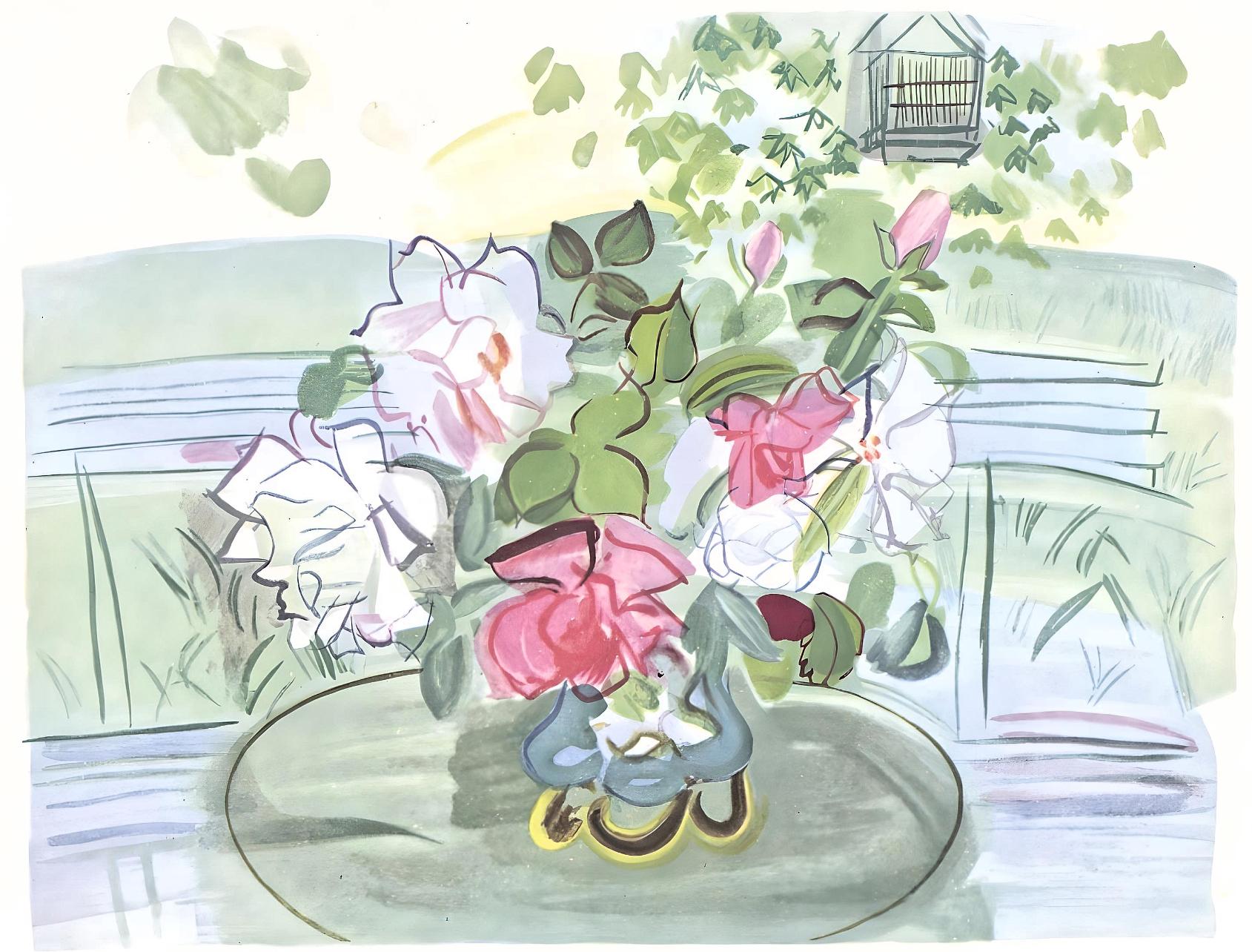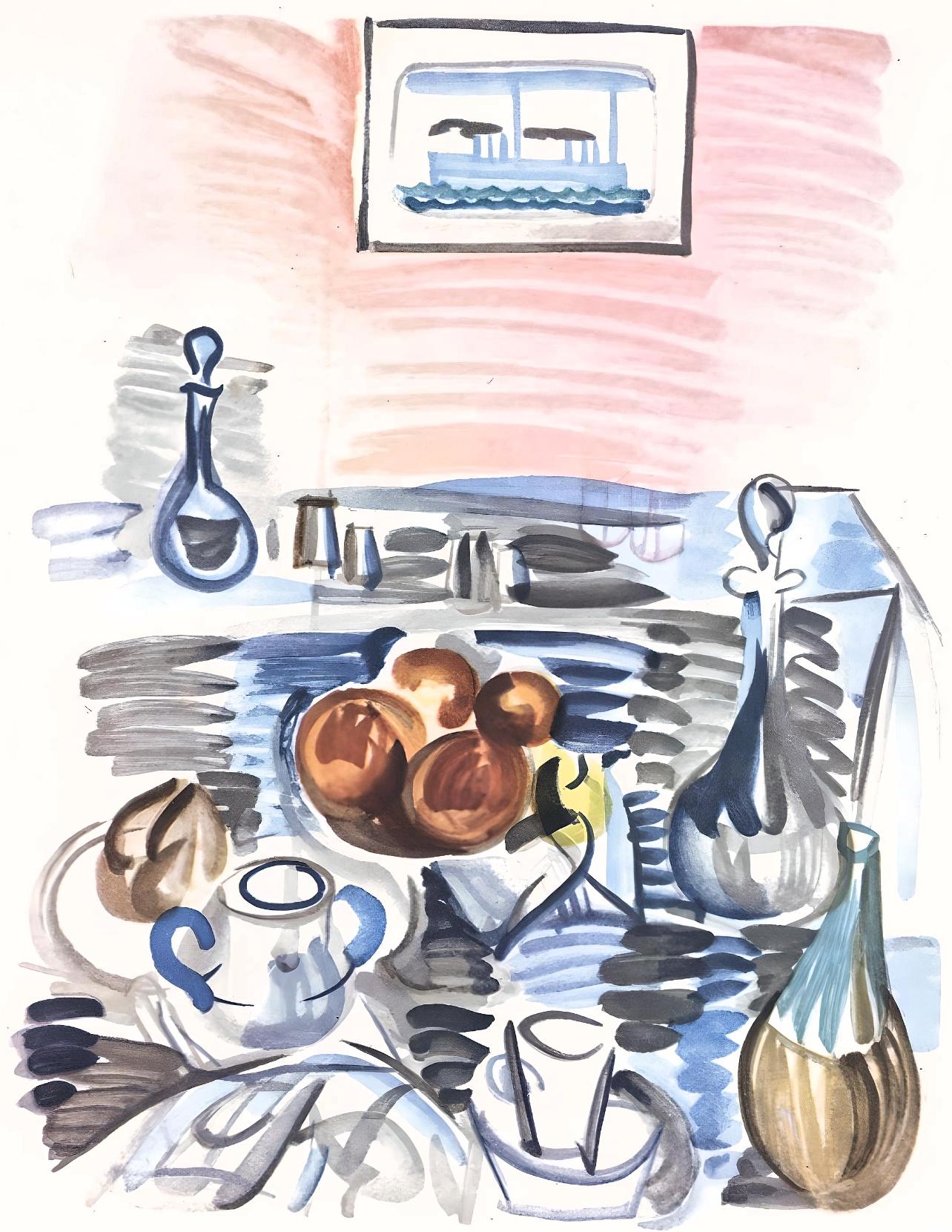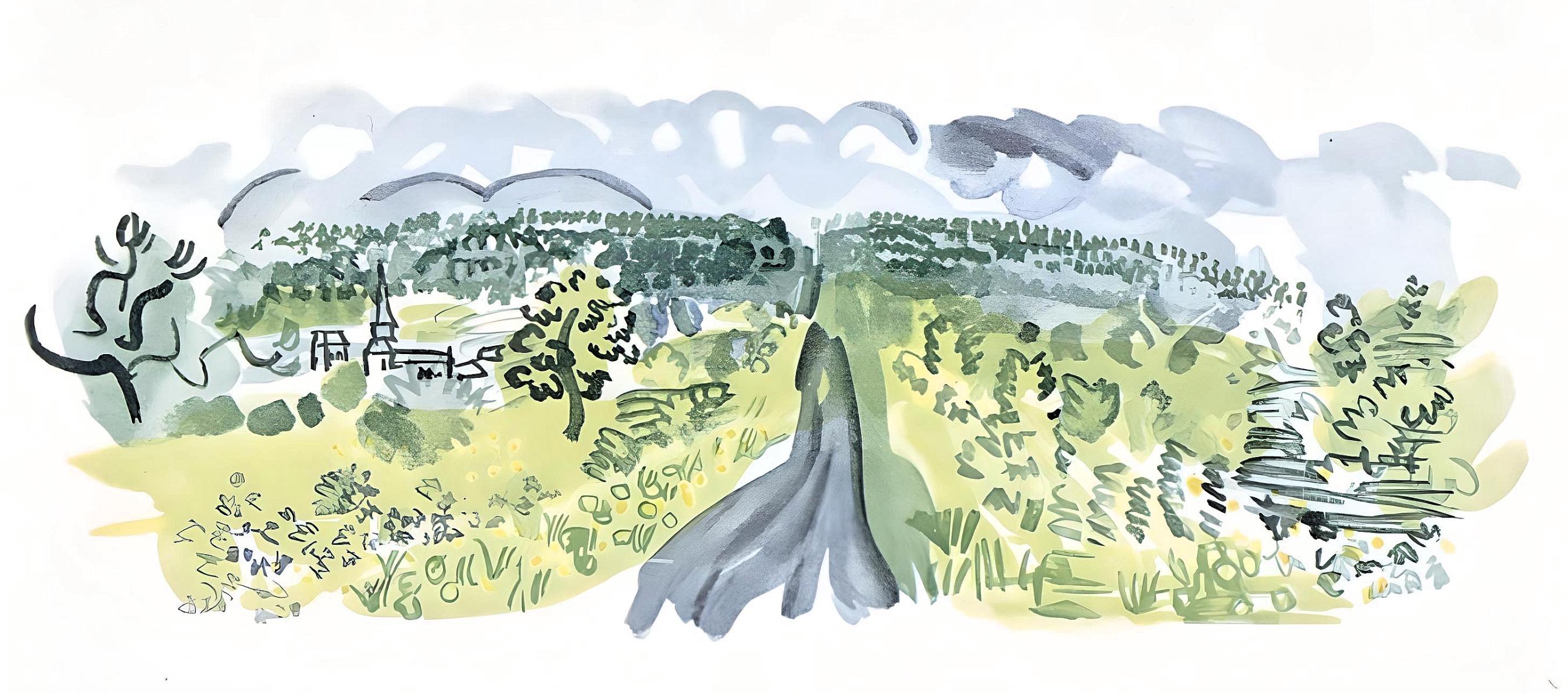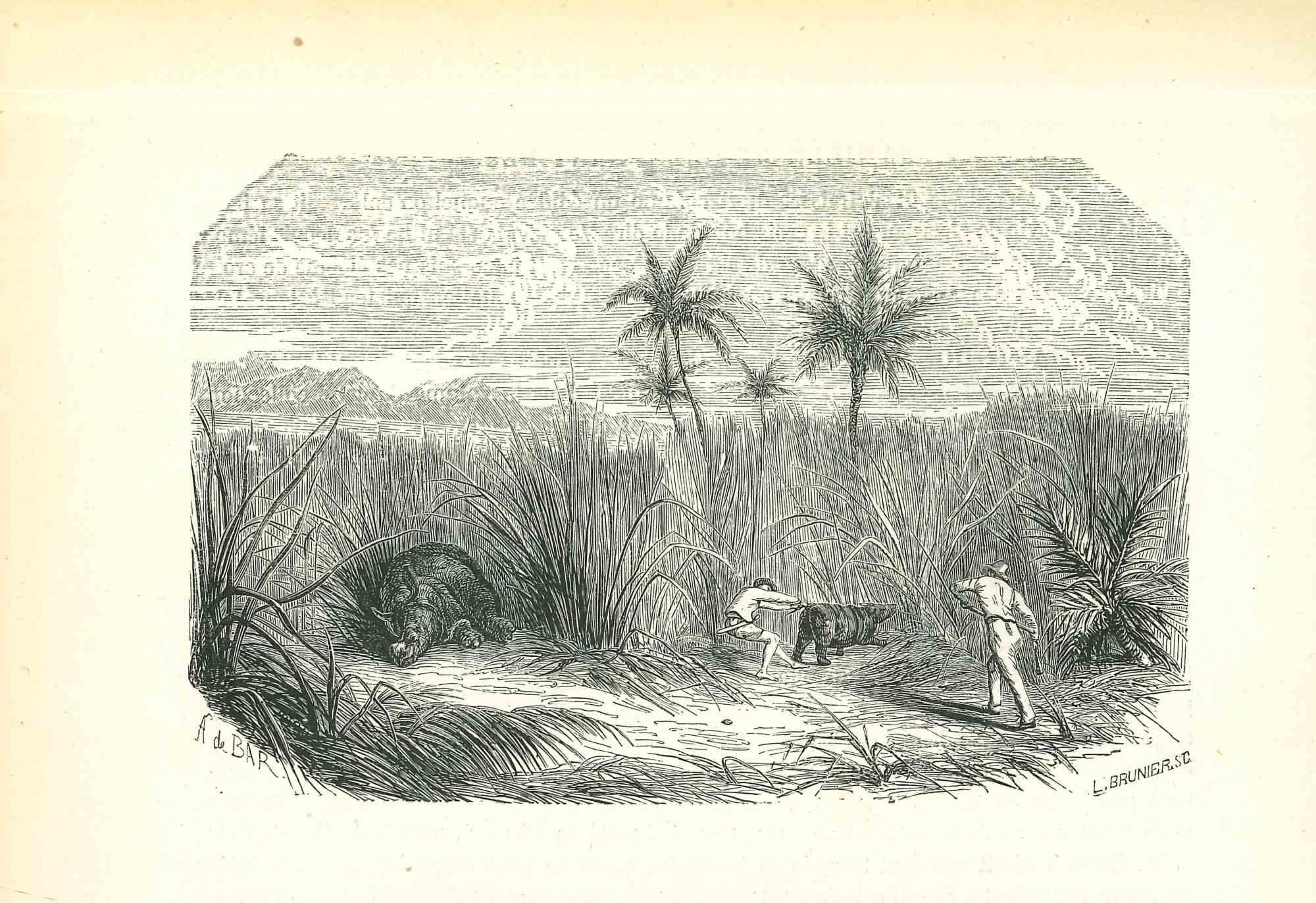Items Similar to Chicago - Lithograph on Paper from "Brockhaus Encyclopedia - 1905
Want more images or videos?
Request additional images or videos from the seller
1 of 2
UnknownChicago - Lithograph on Paper from "Brockhaus Encyclopedia - 19051905
1905
About the Item
Chicago is an interesting black and white lithograph on paper, realized in 1905 by an anonymous artist, and published by Brockhaus Encyclopedia (Brockhaus Enzyklopädie), an encyclopedia in German among the most renowned in the world.
Published in Mannheim by the publisher Bibliographisches Institut & F. A. Brockhaus AG, this encyclopedia appeared in an embryonic form in the 18th century. At the time it was a matter of offering a modern instrument of culture and conversation (Conversations-Lexikon mit vorzüglicher Rücksicht auf die gegenwärtigen Zeiten) to the educated classes. The real encyclopedia would soon be born from the project at the beginning of the 19th century.
This original print is a toponomastic map of the Chicago city, a historical piece to collect!
In good conditions, except for a usual yellowing of the paper at the edges and minor defects and signs of the time.
- Creation Year:1905
- Dimensions:Height: 12.13 in (30.8 cm)Width: 9.85 in (25 cm)Depth: 0.04 in (1 mm)
- Medium:
- Movement & Style:
- Period:
- Condition:Insurance may be requested by customers as additional service, contact us for more information.
- Gallery Location:Roma, IT
- Reference Number:Seller: M-1032551stDibs: LU65035010931
About the Seller
4.9
Platinum Seller
These expertly vetted sellers are 1stDibs' most experienced sellers and are rated highest by our customers.
1stDibs seller since 2017
6,839 sales on 1stDibs
Typical response time: 3 hours
- ShippingRetrieving quote...Ships From: Monaco, Monaco
- Return PolicyA return for this item may be initiated within 14 days of delivery.
Auctions on 1stDibs
Our timed auctions are an opportunity to bid on extraordinary design. We do not charge a Buyer's Premium and shipping is facilitated by 1stDibs and/or the seller. Plus, all auction purchases are covered by our comprehensive Buyer Protection. Learn More
More From This SellerView All
- Alps - Lithography on Paper by A. Lauro - 20th CenturyLocated in Roma, ITAlps is an original lithography artwork on paper realized by A. Lauro in the XX century. The State of preservation is very good. Included a white Passepartout: 34 x 49 cm. The ar...Category
20th Century Modern Figurative Prints
MaterialsLithograph
- Interior of Geneva - Lithograph by Antonio Fontanesi - 19th CenturyBy Antonio FontanesiLocated in Roma, ITThe Interior of Geneve is an original Lithograph realized by Antonio Fontanesi in the 19th Century. The state of preservation of the artwork is excellent. Image Dimensions: 15.5 x ...Category
19th Century Modern Figurative Prints
MaterialsLithograph
- Seascape - Etching by Carlo Carrà - 1964By Carlo CarràLocated in Roma, ITSeascape is an original black and white etching realized by Caro Carrà in 1964. Hand signed on the right margin. Numbered on the lower left. Signed and dated on plate. Edition of 102 copies (16/102), etching on copper. This is one artwork collected in the portfolio "Galleria Grafica Contemporanea", published by Associazione Nazionale per l'Assistenza agli Spastici, Firenze, 1964. Carlo Carrà...Category
1960s Modern Figurative Prints
MaterialsLithograph
- Men at work - Lithograph by Frank Brangwyn - Early 20th centuryBy Sir Frank BrangwynLocated in Roma, ITMen at work is a Lithograph artwork realized between the beginning and the middle of the 20th Century by Frank Brangwyn. The artwork is mounted on passepartout: 32.5 x 49 cm. Good ...Category
Early 20th Century Modern Landscape Prints
MaterialsLithograph
- Maisons sur la Rivière - Lithograph by H. Le Sildaner - Early 20th CenturyBy Henri Le SidanerLocated in Roma, ITMaisons sur la Rivière is an Original Lithograph realized by Henri Le Sidaner (1862-1939). The artwork is in good condition. The artwork is depicted through soft strokes in a well-...Category
Early 20th Century Modern Landscape Prints
MaterialsLithograph
- The Sea - Lithograph After Utagawa Hiroshige - Mid 20th CenturyBy Utagawa HiroshigeLocated in Roma, ITThe Sea is a modern artwork realized in the Mid-20th Century. Mixed colored lithograph after a woodcut realized by the great Japanese artist Utagawa Hiroshige in the 19th century. ...Category
Mid-20th Century Modern Figurative Prints
MaterialsLithograph
You May Also Like
- Bataille de Fleurs (Carnaval of Flowers) from Nice and the Côte d’AzurBy Marc ChagallLocated in Missouri, MOMarc Chagall (1887 - 1985) "Bataille de Fleurs (Carnaval of Flowers)" (from Nice and the Côte d’Azur), 1967 Reference: CS 33 Color Lithograph Image Size: 24 7/16 in x 18 in (62 cm x 45.8 cm) Sheet Size: 29 9/16 in x 20 11/16 in (75 x 52.5 cm) Framed Size: approx. 34 x 27 inches Edition: Numbered 7 of 150 in pencil in the lower left margin and printed on Arches wove paper (aside from an edition of 75 signed and numbered in Roman numerals and 10 artist's proofs). Signature: This work is hand signed by Marc Chagall (Vitebsk, 1887 - Saint-Paul, 1985) in pencil in the lower right margin. Marc Chagall was a man of keen intelligence, a shrewd observer of the contemporary scene, with a great sympathy for human suffering. He was born on July 7, 1887 in Vitebsk, Russia; his original name was Moishe Shagal (Segal), but when he became a foremost member of the Ecole de Paris, he adopted French citizenship and the French spelling of his name. Vitebsk was a good-sized Russian town of over 60,000, not a shtetl. His father supported a wife and eight children as a worker in a herring-pickling plant. Sheltered by the Jewish commandment against graven images, the young Chagall never saw so much as a drawing until, one day, he watched a schoolmate copying a magazine illustration. He was ridiculed for his astonishment, but he began copying and improvising from magazines. Both Chagall's parents reluctantly agreed to let him study with Yehuda Pen, a Jewish artist in Vitebsk. Later, in 1906, they allowed their son to study in St. Petersburg, where he was exposed to Russian Iconography and folk art. At that time, Jews could leave the Pale only for business and employment and were required to carry a permit. Chagall, who was in St. Petersburg without a permit, was imprisoned briefly. His first wife, Bella Rosenfeld, was a product of a rich cultivated and intellectual group of Jews in Vitebsk. Chagall was made commissar for the arts for the area, charged with directing its cultural life and establishing an art school. Russian folklore, peasant life and landscapes persisted in his work all his life. In 1910 a rich patron, a lawyer named Vinaver, staked him to a crucial trip to Paris, where young artists were revolutionizing art. He also sent him a handsome allowance of 125 francs (in those days about $24) each month. Chagall rejected cubism, fauvism and futurism, but remained in Paris. He found a studio near Montparnasse in a famous twelve-sided wooden structure divided into wedge-shaped rooms. Chaim Soutine, a fellow Russian Jew...Category
1960s Modern Figurative Prints
MaterialsLithograph
- Simka Simkhovitch WPA Artist Lithograph Island Beach 1933 American ModernistBy Simka SimkhovitchLocated in Surfside, FLSimka Simkhovitch (Russian/American 1893 - 1949) signed lithograph. Pencil signed and dated "S. Simkhovitch 1933" lower center. Title "Island Beach," in pencil lower left of sheet. Numbered "44/50" in pencil lower right. (it is either Island Beach Wisconsin or New Jersey) Simka Simkhovitch (Симха Файбусович Симхович) (aka Simka Faibusovich Simkhovich) (Novozybkov, Russia May 21, 1885 O.S./June 2, 1885 N.S.—Greenwich, Connecticut February 25, 1949) was a Ukrainian-Russian Jewish artist and immigrant to the United States. He painted theater scenery in his early career and then had several showings in galleries in New York City. Winning Works Progress Administration (WPA) commissions in the 1930s, he completed murals for the post offices in Jackson, Mississippi and Beaufort, North Carolina. His works are in the permanent collections of the Dallas Museum of Art, the National Museum of American Art and the Whitney Museum of American Art. Born outside Kyiv (Petrograd Ukraine) into a Jewish family who owned a small department store. During a severe case of measles when he was seven, Simcha Simchovitch sketched the views outside his window and decided to become an artist, over his father's objections. Beginning in 1905, he studied at the Grekov Odessa Art School and upon completion of his studies in 1911 received a recommendation to be admitted to the Imperial Academy of Arts. Though he enrolled to begin classes in architecture, painting, and sculpture at the Imperial Academy, he was dropped from the school roster in December because of the quota on the number of Jewish students and drafted into the army. Simchovitch served as a private in the 175th Infantry Regiment Baturyn [ru] until his demobilization in 1912. Re-enrolling in the Imperial Academy, he audited classes. Simka Simkhovitch exhibited paintings and sculptures in 1918 as part of an exhibition of Jewish artists and in 1919 placed 1st in the competition "The Great Russian Revolution" with a painting called "Russian Revolution" which was hung in the State Museum of Revolution. In 1922, Simkha Simkhovitch exhibited at the International Book Fair in Florence (Italian: Fiera Internazionale del Libro di Firenze). In 1924, Simkhovitch came to the United States to make illustrations for Soviet textbooks and decided to immigrate instead. Initially he supported himself by doing commercial art and a few portrait commissions. In 1927, he was hired to paint a screen for a scene in the play "The Command to Love" by Fritz Gottwald and Rudolph Lothar which was playing at the Longacre Theatre on Broadway. Art dealers began clamoring for the screen and Simkhovitch began a career as a screen painter for the theater. Catching the attention of the screenwriter, Ernest Pascal, he worked as an illustrator for Pascal, who then introduced him to gallery owner, Marie Sterner. Simkhovitch's works appeared at the Marie Sterner Gallery beginning with a 1927 exhibit and were repeated the following year. Simkhovitch had an exhibit in 1929 at Sterner's on circus paintings. In 1931, he held a showing of works at the Helen Hackett Gallery, in New York City and later that same year he was one of the featured artists of a special exhibit in San Francisco at the California Palace of the Legion of Honor in Lincoln Park. The exhibit was coordinated by Marie Sterner and included four watercolors, including one titled "Nudes". He is of the generation of Russian Soviet artists such as Isaac Pailes, Serge Charchoune, Marc Chagall, Chana Orloff, Isaac Ilyich Levitan, and Ossip Zadkine. In 1936, Simkhovitch was selected to complete the mural for the WPA Post office project in Jackson, Mississippi. The mural was hung in the post office and courthouse in 1938 depicted a plantation theme. Painted on the wall behind the judge’s bench, “Pursuits of Life in Mississippi”, a depiction of black workers engaged in manual labor amid scenes of white professionals and socialites, was eventually covered over in later years during renovations due to its stereotypical African American imagery. The following year, his painting "Holiday" won praise at an exhibition in Lincoln, Nebraska. In 1940, Simkhovitch's second WPA post office project was completed when four murals, "The Cape Lookout Lighthouse and the Orville W. Mail Boat", "The Wreck of the Crissie Wright", "Sand Ponies" and "Canada Geese" were installed in Beaufort, North Carolina. The works were commissioned in 1938 and did not generate the controversy that the Jackson mural had. The main mural is "The Wreck of the Crissie Wright" and depicts a shipwreck which had occurred in Beaufort in 1866. "The Cape Lookout Lighthouse and the Orville W. Mail Boat" depicted the lighthouse built in 1859 and the mail boat that was running mail during the time which Simkhovitch was there. The boat ran mail for the area until 1957. "Sand Ponies" shows the wild horses common to the North Carolina barrier islands and "Canada Geese" showed the importance of hunting and fishing in the area. All four murals were restored in the 1990s by Elisabeth Speight, daughter of two other WPA muralists, Francis Speight...Category
1930s American Modern Landscape Prints
MaterialsLithograph
- Alfred Bendiner, Flic et Bonne (Gendarme and Nursemaid)By Alfred BendinerLocated in New York, NYThe world was Bendiner's oyster, but here he shows us a all we need in a small corner of Paris. It's charming and safe: the 'Flic et Bonne' (gendarme and nursemaid) are together, goi...Category
1950s American Modern Landscape Prints
MaterialsLithograph
- Alfred Bendiner, Rue des Matrys (Paris)By Alfred BendinerLocated in New York, NYWorld traveler that he was, Bendiner was clearly at home in Paris. He found everyone fascinating and has made this print a compendium of local characters and types. Nothing escapes h...Category
1950s American Modern Landscape Prints
MaterialsLithograph
- Alfred Bendiner, Place St. Andre des Arts (Paris)By Alfred BendinerLocated in New York, NYThe Place St. Andre des Arts, on the Left Bank in Paris, would have been a natural environment for Bendiner. It was the Latin Quarter, just south of the Louvre and near everything im...Category
1950s American Modern Landscape Prints
MaterialsLithograph
- 'Financial District', New York City — 1930s American ModernismBy Howard Norton CookLocated in Myrtle Beach, SCHoward Cook, 'Financial District', lithograph, 1931, edition 75, Duffy 155. A fine, richly-inked impression, on cream wove paper, the full sheet with wide margins (2 3/4 to 5 5/8 inches), in excellent condition. Image size 13 5/16 x 10 3/8 inches (338 x 264 mm); sheet size 23 x 16 inches (584 x 406 mm). Matted to museum standards, unframed. Literature: 'American Master Prints from the Betty and Douglas Duffy Collection', the Trust for Museum Exhibitions, Washington, D.C., 1987. Collections: Crystal Bridges Museum of American Art, Library of Congress, Metropolitan Museum of Art, Philadelphia Museum of Art, Smithsonian American Art Museum. ABOUT THE ARTIST Howard Norton Cook (1901-1980) was one of the best-known of the second generation of artists who moved to Taos. A native of Massachusetts, he studied at the Art Students League in New York City and at the Woodstock Art Colony. Beginning his association with Taos in 1926, he became a resident of the community in the 1930s. During his career, he received two Guggenheim Fellowships and was elected an Academician in the National Academy of Design. He earned a national reputation as a painter, muralist, and printmaker. Cook’s work in the print mediums received acclaim early in his career with one-person exhibitions at the Denver Art Museum (1927) and the Museum of New Mexico (1928). He received numerous honors and awards over the years, including selection in best-of-the-year exhibitions sponsored by the American Institute of Graphics Arts, the Brooklyn Museum, the Society of American Etchers, and the Philadelphia Print Club. His first Guggenheim Fellowship took him to Taxco, Mexico in 1932 and 1933; his second in the following year enabled him to travel through the American South and Southwest. Cook painted murals for the Public Works of Art Project in 1933 and the Treasury Departments Art Program in 1935. The latter project, completed in Pittsburgh, received a Gold Medal from the Architectural League of New York. One of his most acclaimed commissions was a mural in the San Antonio Post Office in 1937. He and Barbara Latham settled in Talpa, south of Taos, in 1938 and remained there for over three decades. Cook volunteered in World War II as an Artist War Correspondent for the US Navy, where he was deployed in the Pacific. In 1943 he was appointed Leader of a War Art Unit...Category
1930s American Modern Figurative Prints
MaterialsLithograph
Recently Viewed
View AllMore Ways To Browse
18th Century Lithograph
Antique Encyclopedias
Encyclopedia Antique
City Map Lithograph
Lithograph German 1900
Antique Chicago Maps
Antique Map Chicago
Antique Map Of Chicago
Le Mans Retro Poster
Louis Gerard
Map Of Italy Vintage
Marc Chagall Bella
Mid Century African American Portrait
Mid Century Charcoal And Ink
Northern Song
Notre Dame Lithograph
Nude Female Wall Hanging
Peter Max 1999





